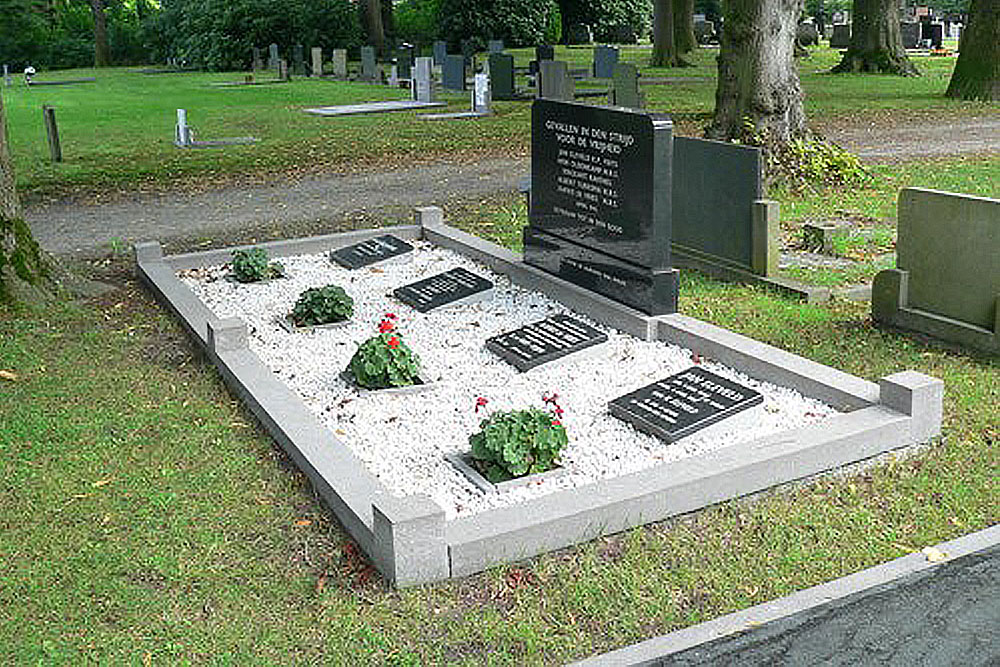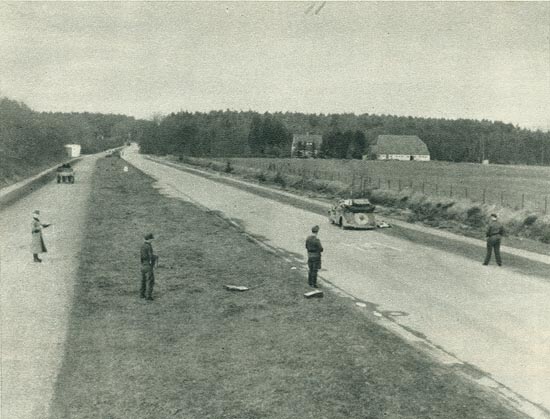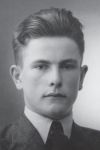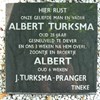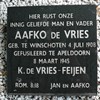Dutch War Graves Smilde
On Kerkenveld Cemetery in Smilde are 4 Dutch war graves and one French war grave, from the French paratroper Jean Marie Ravenel, from World War II.
The war graves are close to the entrance of the cemetery.
Aafko de Vries
De Vries was Chief Guard at the Royal Netherlands Marechaussee in Smilde. He was a member of the LO (National Organization for aid to people in hiding) and also of the GDN (Geheime Dienst Nederland). He spied on the German defenses in Smilde. As a result of the German invasion of [graveid] 50940, Anne Smallenbroek [/ bioid], where information was found about other group members, he was arrested on January 26, 1945 and taken to the detention center in Assen.
A total of 117 men were taken from prisons in Assen, Zwolle, Almelo, Colmschate, Doetinchem and Apeldoorn, to be executed in retaliation for the failed attack on Rauter. The youngest was 17, the oldest 75 years old. De Vries was one of them. All these men were executed in the morning of March 8 at the place where the [towid] 813, Woeste Hoeve monument [/ towid] now stands. On the day of the execution, Aafko was 36 years old, married and had 2 children. In Amsterdam, Amersfoort, Fort De Bilt and on the Waalsdorp setting, a total of 146 men were executed because of the same attack.
Rauter himself had been the initiator of these reprisal measures in the Netherlands. He had even set clear quotas, such as 10 lives for a German dead and 3 for a Dutch dead in German service, etc. In June 1944 Hitler had ordered that the trial of resistance fighters should be stopped. The German SD was then given free rein to do what they wanted with the people they arrested, they became the so-called Todeskandidaten.
In mid-September, Rauter orders the shooting of resistance fighters on the public road in reprisal and leaving their bodies for a long time. Passers-by were forced to watch the executions. In this way they hoped to break the resistance.
With Rauter himself being the victim, it became a massive reprisal. SS Brigadeführer Karl Eberhard Schöngarth took over Rauter's duties. He was responsible for carrying out the retaliation. Yet Rauter himself was no less responsible. He has never been unconscious and Schöngarth has consulted him in hospital.
Albert Turksma
Turksma died at the age of 27 on 8 April 1945 in Diever. A year before that, he married Jitske Pranger. Their son Albert, born in March 1945, died on April 30, 1945 and is buried with his father.
Jan Eleveld
Eleveld was a farmer by trade and during the war a member of the resistance group Smilde. The group came into battle with land guards on April 8, 1945 just across the provincial border at Ooststellingwerf, where Eleveld was killed.
Hein Oldenkamp
Oldenkamp was a branch manager by trade and during the war also a member of the resistance group Smilde. The group came into battle on April 9, 1945 near the Lyclamavaart under Appelscha, where Oldenkamp was killed.
Jean Marie Ravenel
In the night of 7 to 8 April 1945, 46 Stirlings take off from 3 airfields in England to bring the French paratroopers of Operation Amherst to the north-east of the Netherlands. [graveid] 716, but not Ravenel [/ bioid], he and 14 other paratroopers from the stick Lageze are in a plane with engine trouble.
The group soon has to transfer to another aircraft, but because the other aircraft are already too far away, it is decided that they are no longer allowed to take off. Ravenel his colleague Buchart writes about this later; "One by one we have to get out again, harnessed as mules and we must, and that is the pinnacle for a para, to descend that ladder again".
Buchard describes that after a cup of tea, in a room with their parachute as a pillow, they waited the night. He then spoke to Ravenel, who poured out his heart to him and described the course of his life, as well as showing photos of his fiancé and his parents.
In the night of 8 to 9 April their plane left for the Netherlands after all. The group lands in darkness and dense fog close together. Ravenel, who jumped 9th, was found to have collided with a material container in mid-air, causing the parachutes to tangles and not open properly. His colleagues found Ravenel who had died.
Colleague Guyon had broken his leg on landing. He was first hidden and later housed in a nearby farm. Despite this tragic start to their performance, the group attacked a German convoy the same day. Later they conquered the Veenhoopsbrug, so that the explosives placed by the Germans could be removed, assisted by Jan Voortman from Smilde. Later reattached explosives were again removed by Voortman and his father.
The group inflicted heavy losses on a group of 60 German soldiers sent in their direction from Assen. The bridge sometimes "changed hands", but was recaptured by Ravenel's group. They were able to keep it in possession until the first Canadian tank entered the bridge on April 13.
Do you have more information about this location? Inform us!
Source
- Text: Gerrit Hazenberg
- Photos: Gerrit Hazenberg
- Drentsche Kroniek Van Het Bevrijdingsjaar
- Mr G.A. Bontekoe
- Stichting Monument Woeste Hoeve
- De brug van jan Friezo
- Graftombe.nl
- Erelijst.nl
- BONTEKOE, MR G.A, Drentsche Kroniek Van Het Bevrijdingsjaar, Van Gorcum & Comp Assen, Assen, 1946.
- FLAMAND, R. & JANSEN, J.H., Operatie Amherst, Boom, Amsterdam, 2002.
Related books
Nearby
Museum
Point of interest
- Veenhoopsbrug Smilde - Smilde
- Bomb Craters Zuid Hijkerzand - Hijken
- Bullet Holes Hoofdstraat 5 - Hooghalen
Monument
- Memorial Dutch East Indies and Korea - Smilde
- Jewish Memorial Smilde - Smilde
- Resistance Memorial Smilde - Smilde
Cemetery
- French War Graves Smilde - Smilde
- Commonwealth War Graves Hoogersmilde - Hoogersmilde
- Dutch War Graves Cemetery Bovensmilde - Bovensmilde
Remembrance Stone
- Stumbling Stones Veenhoopsweg 49 - Smilde
- Stumbling Stone Veenhoopsweg 58 - Smilde
- Stumbling Stones Hoofdweg 16 - Smilde
Fortification
- German Anti-tank Ditch Zuid Hijkingerzand - Hijken
- Remains German Anti-tank Ditch Hoogersmilde - Hoogersmilde
- German Antitank Ditch Assen - Assen
